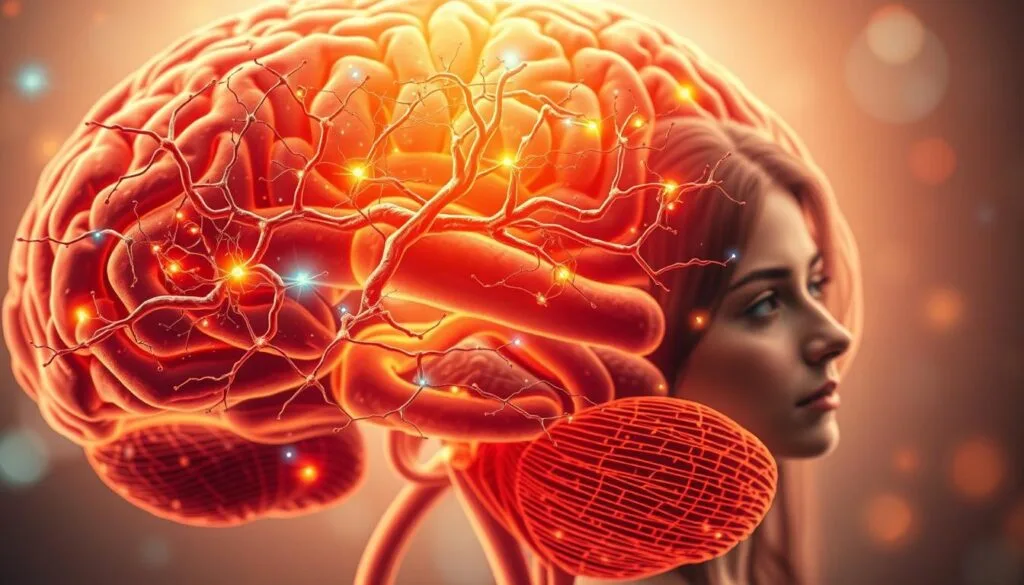Did you know that regularly practicing gratitude can make you happier by up to 25%? This shows how big of an impact having a grateful mindset can have on your well-being. Improving mental health is a key to you keep yourself healthy and happy.
In today’s fast world, it’s easy to forget to be thankful. But taking a moment to appreciate the good things can really help your mental health. It can make you less stressed and happier.
Gratitude is more than just a feeling. It’s a powerful tool that can change how you see things. By looking for things to be thankful for, you train your brain to see the good in life, even when things are tough.
Key Takeaways
- Practicing gratitude regularly can significantly boost happiness and well-being
- Cultivating a grateful mindset helps shift focus to life’s positive aspects
- Gratitude is a powerful tool for improving mental health and reducing stress
- Incorporating gratitude into daily life can lead to increased life satisfaction
- Actively seeking reasons to be thankful trains the brain to focus on the good
Understanding Gratitude and Its Impact on Mental Well-being
Gratitude is a powerful emotion that greatly affects our mental health. It means being thankful and appreciative for the good things in life. By focusing on what we have, not what we lack, we see life in a more positive light.
Studies show that practicing gratitude regularly has many mental health benefits. People who express gratitude often feel happier and more optimistic. These feelings help improve our mental well-being and can reduce stress and anxiety.
Gratitude also helps us build resilience. Resilience is our ability to bounce back from tough times. By being thankful, even when things are hard, we stay strong and keep moving forward. This is key for keeping our mental health stable through life’s ups and downs.
Gratitude impacts many areas of our lives. Here’s a table showing some key areas where gratitude makes a difference:
| Area of Life | Impact of Gratitude |
|---|---|
| Relationships | Strengthens bonds and increases feelings of connection and support |
| Work and Career | Enhances job satisfaction, motivation, and collaboration with colleagues |
| Personal Growth | Fosters a growth mindset, encourages self-reflection, and promotes personal development |
| Physical Health | Reduces stress, improves sleep quality, and boosts the immune system |
By making gratitude a part of our daily lives, we can see a big change in our mental well-being. Whether it’s through journaling, thanking others, or just reflecting on the good things, gratitude can change our outlook. It can make us happier and more fulfilled.
The Science Behind Gratitude and Mental Health
Gratitude can greatly improve your mental health. Science is learning how this works. By knowing how gratitude affects your brain, you can use it to feel better.

Neurotransmitters and Brain Function
Gratitude changes your brain’s chemistry. It boosts serotonin and dopamine levels. These chemicals make you feel happy and motivated.
Practicing gratitude also changes your brain over time. It makes your brain work better for positive thoughts and feelings. This helps you think more positively and handle emotions better.
Psychological Benefits of Gratitude
Gratitude does more than just change your brain. It also improves your mental health in many ways. Some benefits include:
- Increased self-esteem: Focusing on the good in your life helps you feel better about yourself.
- Enhanced empathy: Being thankful for others helps you connect and understand them better.
- Improved social connectedness: Gratitude helps you value and thank the people in your life more.
- Greater emotional resilience: Recognizing the good in your life makes you more optimistic and resilient.
Understanding gratitude’s science can help you live a happier life. Try journaling, mindfulness, or thanking others. Gratitude can bring many benefits to your mental health.
Starting a Gratitude Journal
Starting a gratitude journal can greatly improve your mental health. It’s a simple way to add joy and appreciation to your daily life. By writing down the good things, you can reflect on what makes you happy.
Choosing the Right Format for You
It’s important to pick a journaling format that feels right for you. You might like a traditional paper journal or a digital app. Choose something that you enjoy using every day.
Tips for Maintaining a Consistent Journaling Practice
To get the most out of your gratitude journal, keep up with it every day. Here are some tips to help:
| Tip | Description |
|---|---|
| Set a daily reminder | Make a habit of writing in your journal at the same time each day. It could be in the morning or before bed. |
| Start small | Start with just three things you’re thankful for each day. You can add more as you get into the habit. |
| Be specific | Write about specific moments or people that made you happy. This makes your journal more meaningful. |
| Mix it up | Change up your journal entries to keep it interesting. Try adding photos or drawings to make it more fun. |
Make your gratitude journal a regular part of your day. By focusing on the good things, you’ll feel more positive and mentally well.
Incorporating Mindful Meditation and Gratitude
Mindful meditation and gratitude can boost your mental health. Mindfulness keeps you in the present, while gratitude focuses on the good in your life. Adding gratitude to your meditation can make you more thankful and happy.
To mix gratitude with meditation, say a thankful phrase like “I am grateful for…” while breathing. Think of the people, experiences, and things you’re thankful for. Let the gratitude fill you up.

Guided gratitude meditation is another way to blend mindfulness and gratitude. It asks you to think about the good in your life. Here’s a simple guide to start:
| Step | Description |
|---|---|
| 1 | Find a quiet, comfortable space and sit or lie down. |
| 2 | Close your eyes and take a few deep breaths, allowing yourself to relax. |
| 3 | Bring to mind someone or something you are grateful for, such as a loved one, a cherished memory, or a simple pleasure. |
| 4 | Focus on the feelings of gratitude and appreciation, noticing how they feel in your body and mind. |
| 5 | Continue to reflect on different aspects of your life that you are thankful for, spending a few moments with each one. |
| 6 | When you’re ready, gently open your eyes and carry the feelings of gratitude with you throughout your day. |
Regular mindful meditation and gratitude can make you more positive and mentally strong. Start small, even just a few minutes a day. As you keep up with this, you’ll notice more good in your life and face challenges with ease.
Using Positive Affirmations to Cultivate Gratitude
Positive affirmations are great tools for feeling more grateful. By saying uplifting words, you can change your mind to see the good in life. This helps you appreciate the blessings you have.

Creating Effective Affirmations
When making affirmations, make them personal and specific. Use “I” statements and focus on what you want to attract. Here are some examples:
- I am grateful for the abundance in my life.
- I appreciate the love and support of my family and friends.
- I am thankful for my health and the ability to pursue my passions.
Putting emotion and belief into your affirmations makes them more powerful. This helps change your mindset.
Integrating Affirmations into Your Daily Routine
To get the most from your affirmations, add them to your daily routine. Spend a few minutes each morning and evening saying them. You can also write them down or post them where you see them often.
Being consistent with affirmations is important. The more you practice, the more these positive thoughts will stick. This keeps you grateful, even when things get tough.
Expressing Gratitude Through Acts of Kindness
Showing kindness to others is a powerful way to feel grateful. When you do something nice for someone, you make their day better. You also feel grateful yourself. Kindness and gratitude go hand in hand, creating a positive cycle.

Ideas for Random Acts of Kindness
Random acts of kindness can change someone’s life. Here are some ideas to start:
- Pay for the person’s order behind you in the drive-thru or at a coffee shop
- Write a heartfelt note of appreciation to a friend, family member, or colleague
- Volunteer at a local charity or non-profit organization
- Offer to help a neighbor with their yard work or errands
- Donate books, clothes, or toys to those in need
- Send a care package to someone who is going through a tough time
Remember, kindness doesn’t have to be big or expensive. Even small actions, like giving a genuine compliment or holding the door, can make a big difference.
The Ripple Effect of Kindness and Gratitude
Acts of kindness create a ripple effect that goes far beyond the initial act. When you show kindness, the person you help feels valued. This can inspire them to help others, creating a chain of kindness.
Studies show that kindness and gratitude are good for your mind. People who practice kindness and gratitude often feel less stressed and happier. They also feel more optimistic and satisfied with life.
No act of kindness, no matter how small, is ever wasted. – Aesop
By making kindness a part of your daily life, you can feel more connected and happy. Embrace kindness and gratitude. Watch how it changes your life and the lives of those around you.
Learning to Savor Life’s Moments
In our busy lives, it’s easy to miss out on savoring moments and living mindfully. Yet, taking time to enjoy the simple things can make us happier and more grateful. By slowing down, we can find joy in everyday experiences.
Engaging your senses is a great way to enjoy life. Notice the colors, textures, and tastes of your food. Listen to the sounds and feel the breeze when walking in a park. These moments can make us appreciate life more.

Being thankful for the people and things that make us happy is also important. Think about what you’re grateful for each day. It could be a friend, a beautiful view, or a warm home. Being thankful helps us focus on the good things in life.
Mindfulness can also help you enjoy the present more. Try meditation, deep breathing, or just sitting quietly. These practices help you appreciate life’s beauty. As you get better at this, you’ll find joy in simple things more often.
By savoring life’s moments, you can feel more grateful and happy. Live mindfully, use your senses, and think about the good things in your life. Doing this can turn everyday moments into chances for joy and happiness.
How to Practice Gratitude to Improve Mental Health and Well-being
Adding gratitude to your daily routine can greatly improve your mental health. It helps you focus on the good things in life. This makes you more optimistic and resilient when facing tough times.
Developing a Daily Gratitude Routine
Creating a regular gratitude practice is essential. Try these methods to start:
- Keep a gratitude journal and write down three things you’re thankful for each day
- Take a few minutes to mentally review the positive moments of your day before bed
- Express your appreciation to others through heartfelt compliments or thank-you notes
- Practice mindfulness and savor the small joys in your daily life
Being consistent is key. Make gratitude a part of your daily life, like brushing your teeth. Over time, it will become a natural habit that boosts your mental health.
Overcoming Obstacles to Gratitude Practice
It’s normal to face challenges when trying to stay grateful. Here are tips to help you overcome these obstacles:
- If you forget to practice gratitude, set reminders on your phone or leave notes for yourself
- When feeling low, start small by finding one thing to appreciate, even if it seems insignificant
- If you struggle with negative thoughts, try reframing them in a more positive light
- When life gets hectic, prioritize your gratitude practice as a form of self-care
Remember, overcoming obstacles is part of the journey. Be gentle with yourself and celebrate your small victories. With consistency and dedication, you’ll build a strong gratitude practice that improves your mental health and well-being.
Cultivating Optimism Through Gratitude
Gratitude is a powerful tool for a more positive outlook. By focusing on the good, you can change your mindset from scarcity to abundance. Regular gratitude practice builds resilience and mental strength to face challenges.
Learning to reframe negative thoughts is key to optimism through gratitude. When faced with challenges, negative thoughts can easily take over. But, by focusing on lessons learned and growth opportunities, you can shift to a more optimistic mindset.
Reframing Negative Thoughts
To start reframing thoughts, try these strategies:
- Identify negative thought patterns and challenge their validity
- Look for the silver lining or learning opportunity in difficult situations
- Practice self-compassion and avoid harsh self-criticism
- Surround yourself with positive, supportive people who encourage an optimistic outlook
Focusing on Solutions and Opportunities
Along with reframing thoughts, seek out solutions and opportunities. When facing a problem, focus on finding solutions. Ask yourself:
- What steps can I take to address this challenge?
- How can I learn and grow from this experience?
- What resources or support do I need to move forward?
- How can I use my strengths and skills to create positive change?
“Gratitude turns what we have into enough, and more. It turns denial into acceptance, chaos into order, confusion into clarity…it makes sense of our past, brings peace for today, and creates a vision for tomorrow.” – Melody Beattie
By practicing gratitude and focusing on solutions, you can build a resilient and optimistic mindset. Remember, optimism is a skill that grows with effort and a commitment to personal growth.
The Power of Expressing Appreciation to Others
Gratitude isn’t just about what you’re thankful for. It’s also about expressing appreciation to those around you. When you thank others, you boost their mood and self-esteem. This strengthens your relationships and makes the environment more positive.
One simple way to show gratitude is through positive communication. Instead of focusing on what’s wrong, recognize others’ efforts. Here are a few ways to show your appreciation:
- Thank a coworker for their help on a project
- Compliment a friend on their talents or achievements
- Write a heartfelt note to a family member expressing your love and gratitude
- Acknowledge the hard work of service professionals, such as waiters or cashiers
When you express appreciation, be specific and sincere. Instead of just saying “thanks,” explain why you appreciate them. This makes your words more meaningful and memorable.
Showing gratitude regularly can deeply impact your relationships. It builds connection, trust, and mutual appreciation. When people feel valued, they’re more motivated. By focusing on the positive, you spread goodwill and strengthen relationships in all areas of your life.
Appreciation isn’t just about words. You can also show it through small gestures and acts of kindness. Here are some ideas:
| Gesture | Example |
|---|---|
| Gift-giving | Surprise a friend with their favorite treat or a thoughtful present |
| Acts of service | Offer to help a family member with a task or chore |
| Quality time | Plan a special outing or activity with a loved one |
| Physical touch | Give a heartfelt hug or pat on the back |
By using both words and actions, you can build a culture of gratitude. As you show your thankfulness, others will likely do the same. This creates a more positive and supportive environment for everyone.
Building Resilience with Gratitude
Gratitude is a strong tool for building resilience. It helps us cope with life’s ups and downs. By focusing on what we’re thankful for, we can see the good in tough times.
Studies show that gratitude boosts our mental strength. It makes us feel better, builds strong relationships, and lowers stress. By practicing gratitude, we can stay positive and strong, even when things get hard.
Coping with Stress and Adversity
Here are some ways to use gratitude when stressed or facing challenges:
- Take a moment to think about what you’re thankful for, even if it’s small.
- Write down your thoughts and feelings in a gratitude journal to clear your mind.
- Share your thanks with others to strengthen your relationships.
- Stay present and focus on now, not past troubles or future fears.
Finding Silver Linings in Challenging Times
Even in tough times, there’s always a chance for growth and positive change. By looking for the good, we build resilience and keep hope alive. Here are some examples:
| Challenging Situation | Potential Silver Lining |
|---|---|
| Job loss | Chance to explore new careers or skills |
| Relationship ending | Opportunity for personal growth and self-discovery |
| Health issues | Renewed appreciation for life and focus on self-care |
By seeing challenges as chances for growth, we can overcome adversity. Gratitude is a powerful tool for a resilient mindset. It helps us find joy in life’s journey.
FAQ
Q: How does practicing gratitude impact mental health?
A: Practicing gratitude can act like a superhero for your mental health! Research shows that it helps combat negativity, reducing symptoms of depression and anxiety while boosting your mood. It’s a powerful practice that can create a ripple effect of positivity in your life.
Q: What are some simple ways to feel gratitude daily?
A: Feeling gratitude can be as easy as taking a moment to reflect on the small things that bring you joy. Whether it’s a warm cup of coffee, a sunny day, or someone you know who makes you smile, expressing gratitude for these small moments can enhance your overall well-being.
Q: Can gratitude really help with mental health challenges?
A: Absolutely! Gratitude can help mitigate the effects of mental health challenges by shifting your focus from negative emotions to the positive aspects of your life. Research has shown that grateful people tend to have better health outcomes and greater happiness.
Q: What is the connection between gratitude and happiness?
A: Gratitude is associated with happiness in a big way! When you practice gratitude, you train your brain to recognize and appreciate the good, which can improve your mood and overall sense of well-being. It’s like giving your brain a daily dose of cheerfulness!
Q: How do gratitude interventions work?
A: Gratitude interventions are powerful practices designed to cultivate a grateful mindset. They can include keeping a gratitude journal or sharing your appreciation with someone you know. Research shows that these interventions can significantly enhance your mental health and well-being.
Q: What if I struggle to feel gratitude?
A: Don’t worry; it’s completely normal to have off days! If you find it hard to feel gratitude, start small. Take a moment to reflect on even the tiniest things that you appreciate. Gratitude might just surprise you with its ability to uplift your spirits.
Q: Can gratitude also impact physical health?
A: You bet! Studies suggest that gratitude is associated not just with better mental health but also with improved physical health. When you feel gratitude, your body responds positively, which can lead to better health outcomes and even lower substance use.
Q: How can I incorporate gratitude into my daily routine?
A: Incorporating gratitude into your day can be a simple practice. Try setting aside a few minutes each day to jot down the things you’re grateful for, big and small. This daily practice can significantly impact your mental health and help you focus on the present moment.
Conclusion
We’ve looked at how gratitude can improve your mental health and well-being. We’ve seen how it affects the brain and how to practice it. This includes keeping a gratitude journal, meditating, and thanking others.
Starting a gratitude practice is easy. Begin with small steps like writing down three things you’re thankful for each day. Or, take a moment to enjoy the small pleasures in life. As you keep practicing, you’ll see your outlook change. You’ll find more to be thankful for in your life and the lives of those around you.
Gratitude is a strong tool for better mental health and a positive view of life. By making gratitude a key part of your life, you can enjoy many benefits. It can lead to more happiness, contentment, and emotional well-being. So, take a moment to think about what you’re thankful for. Watch how your gratitude practice can improve your mental health and life.







